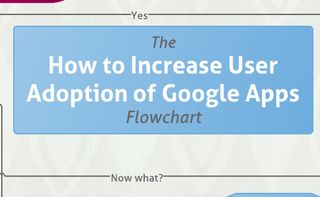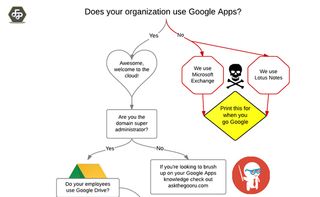5 reasons why you should put visuals into your workflow
Here are five ways that visual elements can have a vast impact on all aspects of business.
The use of imagery and data visualization is core to how we build technology. However, when it comes to the day-to-day aspects of the job (internal and external communication, reporting, training, etc.), most workplaces are still buried in text.
Teams are consistently designing products with visual elements that will wow the client, but often times the feedback and the inspiration behind the result is lost in text-centric emails and documents.
Visual communication is key to more effective ways of streamlining workflows and team interactions, and just getting the job done. Below are five ways you might not be using visuals to improve communications and share information.
01. Try interactive brainstorming to limit revision cycles
When building a complex product like a website, mobile app, or end user survey, visualizations can be invaluable in gathering feedback from key stakeholders from the very beginning of the process. Since design is subjective and difficult to convey via words, interactive design mockups make it easier for everyone to understand the end product and hash out the details.
For example, Curve, a web design agency, uses wireframe mockups to communicate and collaborate with clients. "Simple things like being able to link hotspots together on a wireframe and have them act like live buttons can go a long way in explaining a concept or design to a client," said Simon Read, Curve's User Experience designer.
"Previously we would have had to annotate them with fake notes directly on top, which helped, but wasn't quite as effective as having the client interact with it themselves," he added.
02. Map out potential scenarios and outcomes
When planning for a wide range of scenarios and variables involved in product design, visualizations can eliminate hours wasted working through all the possibilities. Walking through a visual chart enables teams to discover and plan for more variables upfront, rather than having to retroactively address new scenarios after the product has been developed.
Get the Creative Bloq Newsletter
Daily design news, reviews, how-tos and more, as picked by the editors.

For example, BetterCloud, a cloud app management platform for Google Apps with 7.5 million end users worldwide, needs to ensure they are efficient as possible when it comes to writing, testing and implementing code.
Through the use of diagramming solutions, the development team is able to map out countless diagrams that result in real-time collaboration and an overall deeper understanding, which is essential for innovation.
03. Eliminate ambiguity and miscommunication
People gain 75 per cent of what they know visually, 13 per cent through hearing and 12 per cent through smell, touch and taste. Because people learn by seeing, the use of visuals makes for more effective training and minimizes the chance for miscommunications.

The team at BetterCloud also used diagramming solutions in the customer support department. By using this visual method, the team was able to track the entire support process from beginning to end, including steps such as filing bugs, to work directly with the development team solving the issue and better communicating with the customer.
The intelligible process flow also makes it much easier for BetterCloud to train new employees and keep the entire team on the same page.
04. Untangle a complicated product ecosystem
Visuals let people convey complex relationships between information, concepts, or objects more clearly than speaking or writing ever could. Whether it's a mind map, flow chart, or diagram, visuals offer a clean way to share all the inter-connected pieces of the puzzle to let people see the big picture.
For example, Pearson, a provider of learning and educational materials, has thousands of products spread across different business units. Gabe Gloege, Director of Learning and Development at Pearson, decided to create a mind map of all the products. The visual proved so valuable they decided to create 10 ft. posters to hang in each of the North American offices.
05. Break through the monotony
It's easy to get stuck in a rut when you lose sight of the big picture. This can result in lower morale and productivity. Visualization is the perfect vehicle for conveying how even the smallest task fits into the overall operation. For example, instead of just asking copywriters to churn out page after page via email each week, a large chart helps connect the dots between each page of content and emphasizes how it all fits into the broader strategy.
Just as email, texting, and the cloud have changed the way teams communicate, visualization is the next wave to transform workflows. New tools are making it easier than ever for individuals to apply their own visual thinking via flowcharts, mind maps, and mockups. Visuals add another dimension to traditional text and oral communication, bringing new clarity to increasingly complex workplace information.
Words: Karl Sun
Karl Sun is the CEO of Lucid Software, the creator of Lucidchart and Lucidpress, web-based diagramming and design apps. Follow @lucidchart and @lucidpress.
Like this? Read these!
- Brilliant Wordpress tutorial selection
- How to build an app: try these great tutorials
- The best photo apps for iPhone, iPad and Android

Thank you for reading 5 articles this month* Join now for unlimited access
Enjoy your first month for just £1 / $1 / €1
*Read 5 free articles per month without a subscription

Join now for unlimited access
Try first month for just £1 / $1 / €1
The Creative Bloq team is made up of a group of design fans, and has changed and evolved since Creative Bloq began back in 2012. The current website team consists of eight full-time members of staff: Editor Georgia Coggan, Deputy Editor Rosie Hilder, Ecommerce Editor Beren Neale, Senior News Editor Daniel Piper, Editor, Digital Art and 3D Ian Dean, Tech Reviews Editor Erlingur Einarsson and Ecommerce Writer Beth Nicholls and Staff Writer Natalie Fear, as well as a roster of freelancers from around the world. The 3D World and ImagineFX magazine teams also pitch in, ensuring that content from 3D World and ImagineFX is represented on Creative Bloq.
